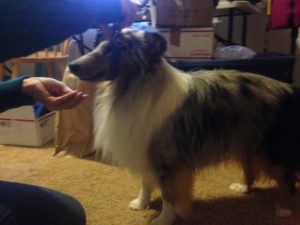There are a lot of dogs, even those who have never been abused or corrected, that do not like to have their collar put on. It can become a terrible cycle of you chasing your dog to catch him–possibly dragging him out from under a bed or from behind something by his fur–and then restraining him while you (or someone else) struggles to get the collar on without getting bit. I have known people that never took their dog’s collar off, even for baths, because they would not be able to get it on again.
Stop Chasing
First off, you need to stop the cycle. Stop chasing, dragging, and restraining. All this is doing is creating even more reasons for your dog to not like putting on his collar. If someone did that to you every time you needed to put your coat on, would you come to it joyful? No.
Start Training
Next, you need to start training. The best way to make the collar a good thing is to turn it into a trick. The dog training facility I used to work at called it “get dressed,” which I think is just adorable. But, you could call it whatever you want.
The words aren’t what matters. What matters is that we are going to teach your dog to come running to you and put his head through his collar or harness willingly and happily.
Don’t believe me? Try it, it works.
Teaching Get Dressed
Here are the instructions for teaching this. Depending on how head shy your dog is, it may take a day or two, or it make take weeks. Move at your dog’s speed in order to be successful.
 As your dog puts his nose through the collar, reward him. Image source: AFairytailHouse.com
As your dog puts his nose through the collar, reward him. Image source: AFairytailHouse.comAlso, in the case of collars (vs. a harness: using a martingale collar is easiest because you don’t have to worry about fussing with a buckle and your dog can’t back out of it. Also, for some dogs, the click of the buckle is part of what bothers them about the collar.
- Start in a small room where your dog can’t get too far away from you. If you can, sit on the floor with your dog to make the scene more relaxed. Have plenty of good treats and his collar.
- Leave the collar on the floor and mark/reward (M/R) your dog every time he approaches the collar or touches it. (kind of like a nose touch with the collar as the target.
- When your dog is deliberately going up to the collar, pick it up and hold it so the big loop (where his head will go) is fully extended. M/R your dog for touching the collar in this new position.
- Then, start delaying your M/R and see if your dog will start to nose the collar more. Eventually he will accidently put part of his nose through the center. M/R BUT DO NOT PUT THE COLLAR ON ALL THE WAY RIGHT NOW.
- Instead, remove it and start again.
- Repeat, upping the criteria as your dog is comfortable, until your dog is pushing his entire head through the collar on his own.
- Once he doing this, you are going to have to work on getting the collar off. Most dogs that are collar shy, also back quickly out of the collar and then run. So, as you start to take the collar off, stop any time your dog starts to back his head or body up. When he is still, continue to remove the collar. This takes patience, but it does work. Eventually your dog will stand still while you pull the collar off.
- Once your dog is putting his collar on by himself, it’s time to start adding distance. Hold the collar several inches away and see if he will walk to put the head through, M/R when successful. Then try a foot or two.
- When he will move to put his head through, you can put it on cue if you wish (the collar being held up can be the cue, or you can use a verbal, like “get dressed”). Do this by saying the cue as your dog puts his head through the collar.
TIP: Standing behind or to the side of the dog, instead of in front, can help your dog be less wary of the collar.
Note on buckles: If you are using a buckle collar, you may find it easier to have two people – one to buckle and one to treat in the beginning. One person will hold open buckle collar up for dog to come and place chin on, other will M/R. Eventually, when he is coming up, laying his head on the collar for you to buckle in one fluid motion and then be rewarded, you will no longer need two people.
Frequently Asked Questions: Collars and Your Dog’s Comfort
Here are the most common questions dog owners ask when their pup refuses to wear a collar—and expert-backed answers to help you handle the situation with care and success.
1. Why does my dog hate wearing a collar?
Dogs may dislike collars due to negative past experiences, discomfort from improper fit, sensory sensitivity, or simply because they aren’t used to the sensation. Identifying the root cause helps in choosing the right strategy to build positive association.
2. How do I choose the right collar for a dog that hates them?
Look for soft, lightweight, adjustable collars made of materials like neoprene or padded nylon. Avoid stiff or bulky designs. Make sure the collar is the right size—snug but not tight—and doesn’t cause chafing or restrict movement.
3. What’s the best way to get my dog used to wearing a collar?
Start slowly with short collar sessions indoors. Use positive reinforcement: offer treats and praise while your dog wears the collar for a few minutes at a time. Gradually increase the duration as your dog becomes more comfortable.
4. Should I leave the collar on all day?
Not at first. For dogs that dislike collars, it’s better to introduce collar time in short, pleasant intervals. Once your dog is accustomed and there are no signs of irritation, you can decide whether all-day wear is appropriate based on safety and supervision.
5. What are signs my dog is too uncomfortable in their collar?
Watch for scratching, pawing at the collar, whining, refusing to move, or signs of skin irritation. If your dog shows any of these behaviors, remove the collar and check for fit or material issues.
6. Are harnesses better than collars for collar-averse dogs?
Harnesses can be a great alternative, especially for walks or training sessions. However, collars are still useful for ID tags and quick handling. If your dog strongly resists collars, start with a harness while gradually building collar tolerance.
7. Can a bad experience make my dog hate collars permanently?
Not necessarily. Dogs are resilient, and with patience and positive conditioning, most can overcome past negative associations. Use gentle methods and never force the collar—this builds trust and encourages long-term comfort.
About the Author
Based in Wilsonville, Ore., animal lover Kristina N. Lotz is a Certified Professional Dog Trainer – Knowledge Assessed (CPDT-KA) and works as a full time trainer. She is the founder of A Fairytail House, a unique all-positive all-sport dog training facility that helps rescue dogs in her area and provides free seminars and training classes for the community. In her spare time, she trains and competes in herding, agility, obedience, rally, and conformation with her Shetland Sheepdogs. She smartly married a Veterinary Technician, who helps keep the fur kids happy and healthy, and provides a quick resource for articles.

 2 days ago
5
2 days ago
5


















 English (US) ·
English (US) ·